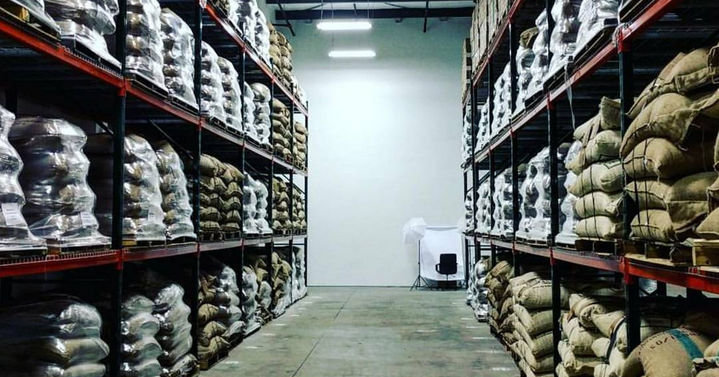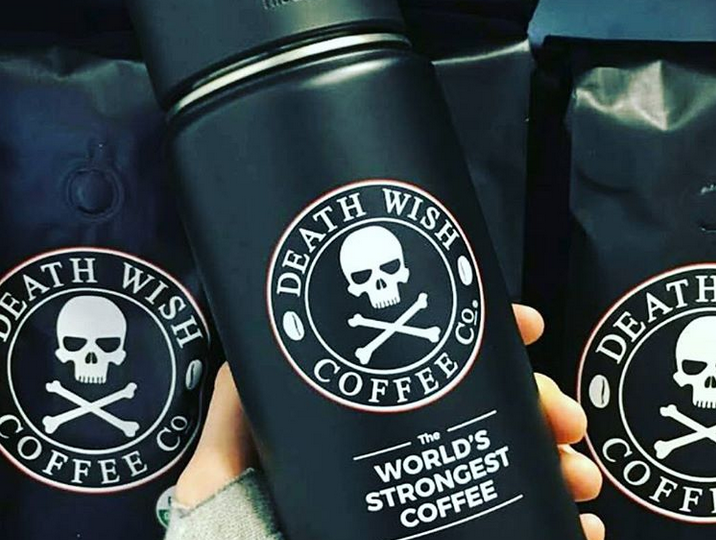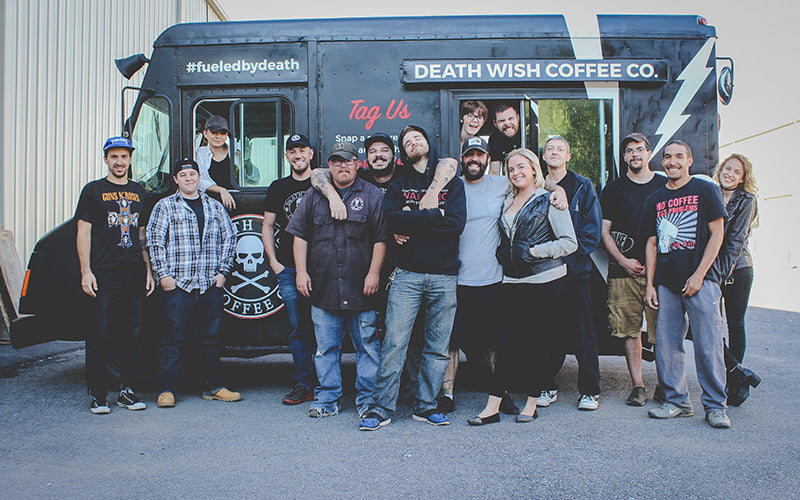When Mike Brown visits his mother these days … the first thing he sees when he arrives is himself:

“It’s really awkward. Just before the Super Bowl last year someone gave her a poster with a big picture of my face on it and she hung it on the front door and it has been there ever since.”
The poster was created to announce that the company Brown founded, Death Wish Coffee, had beaten out fifteen thousand other contestants to win a free Super Bowl commercial. The commercial was a huge success — as we’ll illustrate in just a moment — but it’s important to understand why Brown’s mother is so proud.
Winning the Super Bowl — that is, a commercial during the big game — seemed impossible back in 2010.
That’s when Brown, thirty years old at the time, opened a small coffee shop in upstate New York and struggled so much he was forced to sell his home, move back in with his mother, and borrow money from her just to make payroll.
“My mother was there for me when I needed her most,” Brown says.
Hundreds of sleepless nights and coffee-bean experiments later though, Brown had created exactly what his local customers had been asking for: the strongest coffee in the world.
Fast forward several years and Death Wish Coffee is now a well-known brand and a multi-million dollar company.
Brown has since moved out of his mother’s home, unless you count that poster she doesn’t seem interested in taking down: “No I haven’t asked her to take it down. Maybe it’s the vanity in me but I’m okay with mom keeping the poster up.”
Who wouldn’t be? Especially when you consider it helped Death Wish generate …
More than Two Thousand Dollars a Minute
Let’s get something straight.
Before we discuss how successful the Super Bowl commercial was, you need to know Death Wish Coffee was a big success prior to the commercial and would have been even had it not been front and center during the big game.
“We don’t want the Super Bowl to define us,” says Kane Grogan, Death Wish’s customer service manager. “The Super Bowl commercial was a great spotlight but we were doubling sales every year prior to it.”

Now that you know Death Wish was on fire prior to the Super Bowl, think about the commercial as pouring gasoline all over it and watching it burn even hotter.
“The Super Bowl didn’t change us. It just accelerated the growth we were already experiencing.”
“The commercial definitely worked. We had the best two hour sales period ever.”
Specifically, Death Wish Coffee generated more than a quarter-million dollars in two hours. That’s more than $2,083 a minute.
Over that time the company, which runs on Shopify — an enterprise ecommerce solution for high volume merchants — experienced a massive spike in traffic as more than 150,000 visitors crammed their way onto the site to order.
Since then, Brown and his team say many doors have opened:
- Death Wish Coffee grew 200% year over year
- Subscribers now provide it with predictable recurring revenue
- New wholesale opportunities emerged including Death Wish Coffee now being offered in 250 Safeway groceries on the West coast
Impressive for sure.
However, the Death Wish team points to something even more valuable than the commercial itself: the story behind the commercial that was told over and over.
“The media attention we got after winning the contest was insane,” Grogan says. “We were on every major television and cable network and Mike did one hundred interviews himself.”
The company estimates the attention earned it a half a billion impressions: a success by any metric. But only because Death Wish Coffee had tenaciously prepared so history would not repeat itself…
Thankful for Ecommerce Carnage?
The Super Bowl wasn’t the first time the publicity gods smiled on Death Wish.
In 2013, just as the company was really beginning to grow, Death Wish Coffee found itself in the spotlight of ABC’s Good Morning America, which wanted to profile Brown and the caffeine-jacked blend he had created.
What should have been a blessing, wound up a nightmare.
Brown’s original patchwork website couldn’t handle the spike in traffic. Before it crashed, Death Wish received ten-thousand new orders but had no way to fulfill them on time.
People thought Death Wish was a scam, the company was kicked off major online selling platforms, and some orders took thirty days to fulfill.
“There’s part of me,” Grogan recalls, “that was glad it happened. It taught us we had to be prepared for big events like the Super Bowl.”
Subsequently, Death Wish replatformed with Shopify to fix its reputation and set its sights on automating and simplifying its operations. It’s why Death Wish also partnered with Skubana, a provider of multi-channel inventory management and ERP software for high performing merchants.

Death Wish & Skubana In Action
For instance, Death Wish has its own warehouse but also keeps inventory in third-party warehouses and a distribution center. Likewise, the company sells its coffee through multiple channels: Shopify, Amazon, and wholesale.
Skubana tracks Death Wish’s inventory across multiple locations and channels and provides a single automated report so Brown can easily see how his business is performing in real time. In Brown's words:
“Without Skubana I’d be a bit more blind. The data we have is scattered in twenty different places. With Skubana, all of that data is automatically consolidated and right there at my fingertips.”

Additionally, Skubana also alerts Death Wish when a particular item is not selling and suggests discounting it. The software tracks Death Wish’s profitability and also prevents the company from over selling an item or running out of a particular SKU.
“It simplifies everything,” Brown says. “Instead of pulling reports and trying to put together all the pieces manually, Skubana allows me to focus on growing the business.”
The result is a more focused company with the ability to operate seamlessly and scale even quicker than before.
Skubana’s cloud-based centralized platform positions to merchants to troubleshoot, diagnose problems, and prescribe fixes in real time instead of taking days or weeks as might have in the past.
Chad Rubin, Skubana’s co-founder, explains:
“On top of the convenience, Skubana utilizes algorithmic purchase orders that will prepare your purchase orders at the right time, with the right information, awaiting your approval.
“It’s a tool that does forecasting, demand planning, and even can project profitability.
“By using Skubana’s algorithmic technology to automate repetitive tasks, it allows multi-marketplace sellers to invest time in things that create high impact on the bottom line.”
No longer having to manually pull reports frees Death Wish to make smarter business decisions. It also means customers may soon be experiencing Death Wish much differently.
Over the Top
That’s the kind of customer service Grogan strives to offer.
In fact, Death Wish has been recognized as having some of the best ecommerce customer service in existence, despite its phenomenal growth.
“We don’t want to be one of those companies that gets big and loses touch with its customers.”
“We’re evolving into more of a lifestyle brand want to be over the top with our customer service because the customer calls the shots today and they’re the reason we’re here.”
Today, Death Wish has to log in to each social media account individually and manually respond to customers.
In the future, expect Death Wish to invest in technology that will alert the company immediately when someone is talking about it, funnel all customer inquiries into one area, and illustrate the history the company has with that customer so Grogan can respond faster and more personally.

“We really want to offer customers a meaningful one-on-one interaction with Death Wish Coffee,” Grogan says.
It’s the type of thoughtfulness Brown’s mother is known for. With a grin, Grogan reveals:
“It’s hilarious because she actually calls customer service when she needs something because she doesn’t want to bother Mike while he’s working. As soon as the customer service rep realizes who it is they’re like, ‘Oh my gosh it’s Mike’s mom!’”
It’s a call Brown always takes … even if she’s not interested in taking down his poster. In Brown’s words: “She’s the best.”
Read more
- How Nestlé Is Using Shopify Plus to Target Millennials by Making Adulthood Suck Less
- How Big Brands Rock Offline Marketing Strategies to Get Real with Customers
- Ecommerce Migration Case Study: Leading UK Retailer Migrates 11.1M+ Data Points in 16 Weeks
- How an Indian Retail Conglomerate Sells Across Global Online Marketplaces
- The Decision That Made Raging Mammoth Grow 1,300% in Just Six Months
- After Ecommerce Sales Surged 72%, Thermacell Turns its Eye to Wholesale
- Digital Transformation: How YM Inc. Is Using Shopify Plus to Reimagine Its Retail Future … Online
- SweetLegs Migrated 21 Days Before Black Friday, Then Broke All Its Holiday Records
- A “Golden” Opportunity: How Activewear Brand Rhone Disrupted Itself Two Years After Launching
- How a South Korean Entrepreneur Uses Homemade Cookies to Grow a Little Girl’s Fashion Brand 50% Every Month


